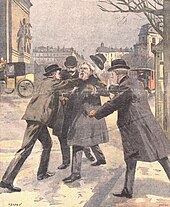
Back عدوان Arabic Agresión AST Aqressiya AZ Агресия Bulgarian དྲག་ཤུལ། BO Agresija BS Agressió Catalan شەڕانگێزی CKB Agrese Czech Ymosodedd CY


Aggression is a behavior aimed at opposing or attacking something or someone. Though often done with the intent to cause harm, it can be channeled into creative and practical outlets for some.[1] It may occur either reactively or without provocation. In humans, aggression can be caused by various triggers. For example, built-up frustration due to blocked goals or perceived disrespect.[2] Human aggression can be classified into direct and indirect aggression; while the former is characterized by physical or verbal behavior intended to cause harm to someone, the latter is characterized by behavior intended to harm the social relations of an individual or group.[3][4][5]
In definitions commonly used in the social sciences and behavioral sciences, aggression is an action or response by an individual that delivers something unpleasant to another person.[6] Some definitions include that the individual must intend to harm another person.[7]
In an interdisciplinary perspective, aggression is regarded as "an ensemble of mechanism formed during the course of evolution in order to assert oneself, relatives, or friends against others, to gain or to defend resources (ultimate causes) by harmful damaging means. These mechanisms are often motivated by emotions like fear, frustration, anger, feelings of stress, dominance or pleasure (proximate causes). Sometimes aggressive behavior serves as a stress relief or a subjective feeling of power."[8][9] Predatory or defensive behavior between members of different species may not be considered aggression in the same sense.
Aggression can take a variety of forms, which may be expressed physically, or communicated verbally or non-verbally: including anti-predator aggression, defensive aggression (fear-induced), predatory aggression, dominance aggression, inter-male aggression, resident-intruder aggression, maternal aggression, species-specific aggression, sex-related aggression, territorial aggression, isolation-induced aggression, irritable aggression, and brain-stimulation-induced aggression (hypothalamus). There are two subtypes of human aggression: (1) controlled-instrumental subtype (purposeful or goal-oriented); and (2) reactive-impulsive subtype (often elicits uncontrollable actions that are inappropriate or undesirable). Aggression differs from what is commonly called assertiveness, although the terms are often used interchangeably among laypeople (as in phrases such as "an aggressive salesperson").[10]
- ^ Maremmani I., Avella M.T., Novi M., Bacciardi S., Maremmani A.G.I. Aggressive Behavior and Substance Use Disorder: The Heroin Use Disorder as a Case Study. Addict. Disord. Treat.. 2020;19(3):161-173. doi:10.1097/ADT.0000000000000199
- ^ DeBono, Amber; Muraven, Mark (1 November 2014). "Rejection perceptions: feeling disrespected leads to greater aggression than feeling disliked". Journal of Experimental Social Psychology. 55: 43–52. doi:10.1016/j.jesp.2014.05.014. ISSN 0022-1031.
- ^ De Almeida, Rosa Maria Martins; Cabral, João Carlos Centurion; Narvaes, Rodrigo (2015). "Behavioural, hormonal and neurobiological mechanisms of aggressive behaviour in human and nonhuman primates". Physiology & Behavior. 143: 121–35. doi:10.1016/j.physbeh.2015.02.053. PMID 25749197. S2CID 27711931.
- ^ Miczek, Klaus A.; Almeida, Rosa M. M. de; Kravitz, Edward A.; Rissman, Emilie F.; Boer, Sietse F. de; Raine, Adrian (31 October 2007). "Neurobiology of Escalated Aggression and Violence". Journal of Neuroscience. 27 (44): 11803–11806. doi:10.1523/JNEUROSCI.3500-07.2007. ISSN 0270-6474. PMC 2667097. PMID 17978016.
- ^ Hollowood, Lorna (2022). "Micro refers to its subtle delivery not its impact". rcn.org.uk. Royal College of Nursing.
Microaggressions are something that somebody says to you; they can be a way that you've been made to feel. They are often subtle behaviours, but their effects are far from subtle
- ^ Buss, A. H. (1961). The psychology of aggression. Hoboken, NJ: John Wiley.[page needed]
- ^ Anderson, Craig A.; Bushman, Brad J. (2002). "Human Aggression". Annual Review of Psychology. 53: 27–51. doi:10.1146/annurev.psych.53.100901.135231. PMID 11752478. S2CID 227846.
- ^ Wahl, Klaus (2020). The Radical Right. Biopsychosocial Roots and International Variations. London: Palgrave Macmillan. p. 47. ISBN 978-3-030-25130-7. OCLC 1126278982.
- ^ Wahl, Klaus (2013). Aggression und Gewalt. Ein biologischer, psychologischer und sozialwissenschaftlicher Überblick. Heidelberg: Spektrum Akademischer Verlag. p. 2. ISBN 978-3-8274-3120-2. OCLC 471933605.
- ^ Akert, R.M., Aronson, E., & Wilson, T.D. (2010). Social Psychology (7th ed.). Upper Saddle River, NJ: Prentice Hall.